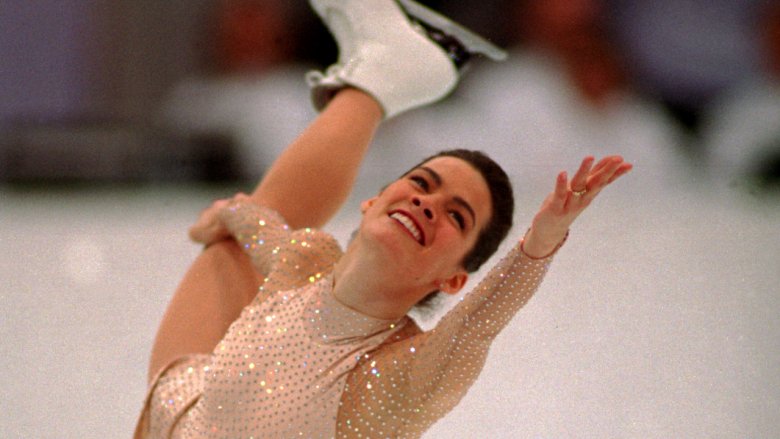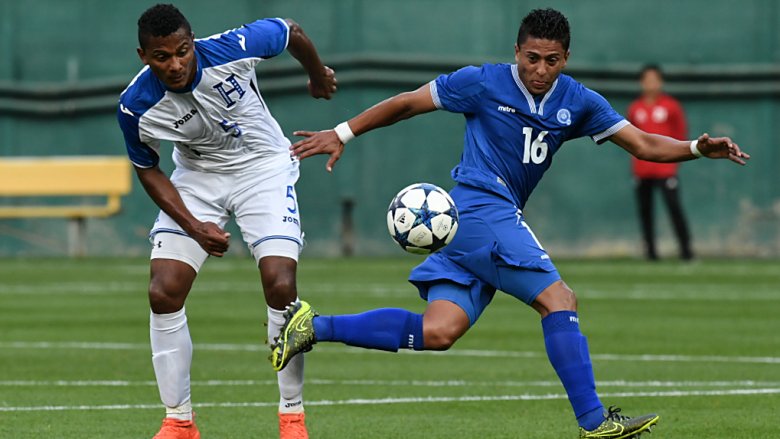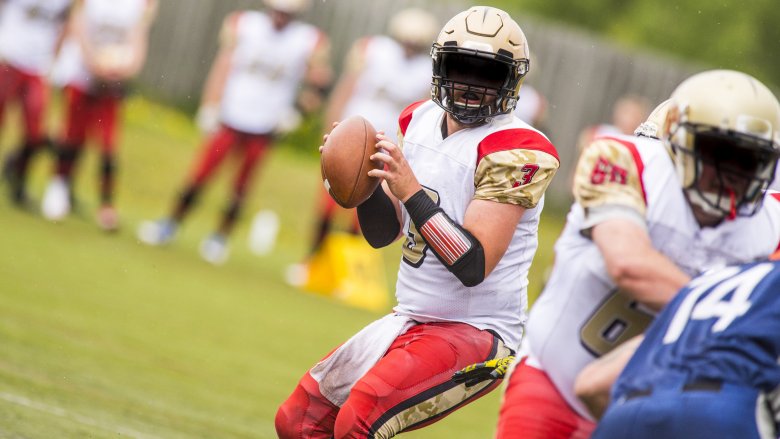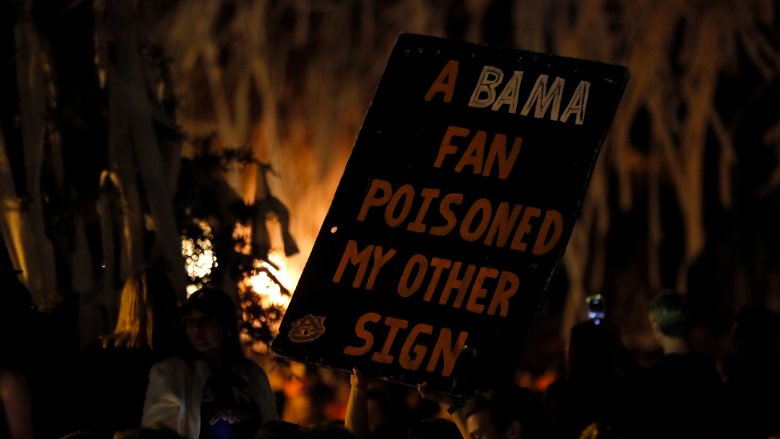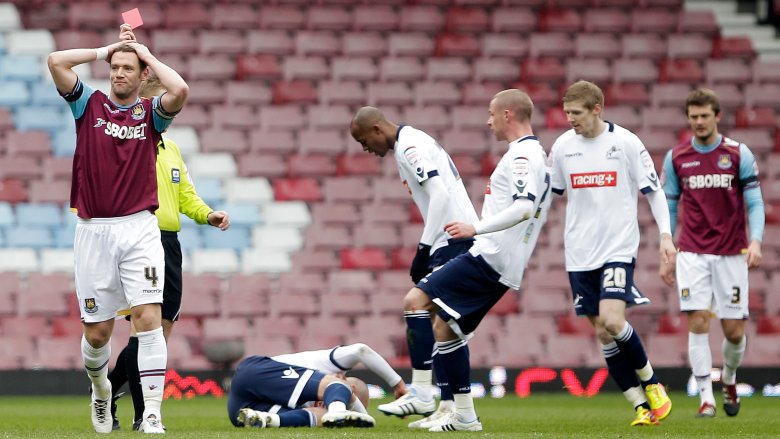Sports Rivalries That Took Things Too Far
If you're into sports, there's nothing like watching a game. The adrenaline pounding, the pride in your heart when you win — it's something non-sports lovers will never understand.
What they might point out, however, is that love of sports can go too far. Individuals can take their sports rivalries to the next level, where people get a little too involved. You don't have to prove how much better you are by getting violent or doing anything illegal. Kidnapping certainly shouldn't be on your list of options, nor should getting out a knife. And it's not just the fans that can overreact, but the players, too. In at least one case it was whole countries that went overboard.
It's fine to love your team and rock their colors or jerseys. But it's important to remember that it's just a game. Sports rivalries should be fun, not something that gets the police involved.
Honduras and El Salvador go to war over soccer
Tensions had been simmering between El Salvador and its neighbor Honduras for 20 years due to complex political issues like immigration. But in 1969 it all came to a boil, thanks in part to a series of soccer games between the two countries.
Countries in different regions have to play each other to try and get a spot in the World Cup. For most of the world, soccer is a religion and these games are a big deal. The first match was on June 8 in Honduras. Rumors started that when the team was there they had been harassed. So when the Hondurans went to El Salvador for the next game things got out of hand. According to the Association for Diplomatic Studies and Training, people stood on the side of the road and shot into the Hondurans' team bus. Then they gathered outside the hotel where the team was staying and screamed all night so no one could sleep, hoping to affect their play the next day. Then a riot broke out at the game itself. In retaliation for their team's treatment, people in Honduras dragged El Salvadoran immigrants from their homes and beat them.
ThoughtCo says the situation wasn't helped by the media coverage or open displays of extreme national pride around the matches. Within a few short weeks the countries were at war. While it only lasted four days, over 4,000 people died, including civilians. All thanks to some intense soccer games.
Ouachita Baptist and Henderson State get creative
It's not just big-name sports teams that have harsh rivalries. Even the little guys can get a bit crazy. According to CBS Sports, the biggest fight in college football's Division II is "a backyard brawl -– almost literally." Ouachita Baptist and Henderson State have gone at it every year since 1895 in the Battle of the Ravine.
Like most college teams, there are the pranks, like crop-dusting the other school with marshmallows. But then there's the prank that went a little bit too far. In 1946 a lovely lady named Ann Strickland was attending Ouachita and had just been named the homecoming queen. One day, a car of people she knew from her childhood pulled up next to her and encouraged her to get in. The key was that all of them now attended her rival, Henderson. A group of students had literally kidnapped the homecoming queen.
Sure they didn't mean her any harm, but if it happened today they'd be explaining themselves to the FBI. They took Strickland to a lake house 30 miles away and kept her there for days, not letting her leave. So yeah, this was a real kidnapping.
Meanwhile, Ouachita was going nuts looking for her, including her boyfriend, the defensive back. He showed up at a hotel she was rumored to be being held at with a shotgun hidden under his clothes and started banging on doors. Fortunately, no one was shot. Strickland was eventually released, and the game went on as usual.
Canada and the Russians clear the benches
The Cold War elicited a lot of hard feelings in sports, even leading to two boycotts of the Olympic games. But it didn't stop there. According to the New York Times, a 1987 Canada-USSR hockey game broke out into a 20-minute free-for-all. This punch-up was a little different, though. The two teams were playing for the world junior hockey championship and all the players were under 20 years old. Now, we can't be sure if complex international relations started this particular brawl, but it makes as much sense as any other guess.
It starts normal enough, for hockey. Two kids take off their helmets and start punching each other in the face while the refs try to break it up. Then another fight breaks out, with one player holding another down on the ice and slugging him. By this point the announcer is in shock, saying you just don't see this kind of thing in international hockey. But it gets worse. Another fight breaks out, which the goalie watches for a while before deciding to get involved. Suddenly everyone is on the ice and throwing punches. The announcer is apoplectic. Helmets and sticks are all over the place.
So it was a pretty weird way to spend 20 minutes. Both teams were disqualified, and other countries walked away with the medals. The fight was so bad it would become known as the Punch-up in Piestany.
El Masry and El Ahly end in tragedy
If there is soccer, there is rivalry. Even in Egypt where teams El Masry and El Ahly go at it. But one match went from sports rivalry to epic tragedy.
Egypt Today says the major issues started at halftime. Fans of El Masry lit stuff on fire and started throwing it on the pitch. Possibly thinking that playing with fire is fun, some fans invaded the pitch as well. They were cleared off before the second half started, but things got worse when play started up again. El Masry fans started attacking El Ahly's bench and kept throwing flames around. They invaded the pitch again and then security made a big mistake when clearing them off — they let the El Masry fans go to the El Ahly area. According to the BBC, this may have been by design. El Ahly fans had recently been involved in some anti-police demonstrations and the cops guarding the game may have hoped they'd be put in their place a little. But they can't have wanted what happened because that's when the killing started.
It would become one of the greatest soccer disasters of all time. People had smuggled knives into the stadium, and as the game ended they started using them on the other team's fans. Some people tried to protect their team's players. Some victims died in a stampede as everyone fled the violence. In the end 74 people were killed in what became known as the Port Said Massacre.
Auburn and Alabama get petty
These two Alabama-based colleges first met on the field in 1893 and continue to fight it out yearly in the Iron Bowl. Like a lot of local rivals, they had their scuffles over the years, but nothing was as bad as one prank (if you can call it a prank) gone way too far.
First, you have to understand the significance of Toomer's Corner. According to CNN, this intersection in downtown Auburn is named for the 120-year-old drugstore on the corner, but it was most notable for the giant 130-year-old oaks across the street. After Auburn games, students would descend on Toomer's Corner and cover the trees with toilet paper. Sure, that probably wasn't fun for whoever had to clean it up, but it was basically innocent fun.
Then in 2010 it all came to a sudden end. According to ESPN, a guy called in to a local radio show to say that after Auburn beat Alabama that year he had driven 30 miles and dumped a very strong herbicide on the two trees. He called himself "Al from Dadeville" and signed off by saying "Roll Damn Tide."
It wasn't a joke. The soil around the trees was tested and nothing could be done — the trees were going to die. "Al" was eventually found and sentenced to six months in jail. The trees were removed in 2011 and finally replaced in 2015.
Giants and Dodgers don't just use their fists
The 1960s was a crazy time, and some of that craziness extended to sports. Things got really hot during one Giants-Dodgers game in 1965, according to the Sacramento Bee.
On that day in 1965, the rivalry would take a violent turn. According to CBS Sports, the Giants' pitcher Juan Marichal threw some balls a little too close to the batters for their liking. The stage was set. When it was Marichal's turn to bat, catcher John Roseboro told Dodgers' pitcher Sandy Koufax to do the same thing to him. Koufax chose not to hit Marichal, so the catcher thought he would do it himself. As he threw the ball back to the mound he brushed by the batter's head, possibly even clipping his ear. Marichal wasn't having it, but he didn't use his fists like in normal baseball fights. He turned and hit Roseboro twice with his bat, cutting the catcher's head. Roseboro walked away bloodied and shaken and had to be watched for signs of concussion the rest of the night. Then a 15-minute brawl broke out that cleared both benches. Asked the next day what punishment Marichal should get, Roseboro asked for 10 minutes in a room with him.
Fortunately, there were no lasting hard feelings. Marichal was even an honorary pallbearer at Roseboro's funeral in 2002.
Blues and Blackhawks set a record
Hockey is full of rivalries, and it's fair to say that fights start over someone looking at somebody the wrong way, but that doesn't change the fact that the Blues and Blackhawks have a particular hatred for one another. And in 1991 it got bad.
The Riverfront Times put it like this: "The St. Louis Blues and Chicago Blackhawks beat the living crap out of each other. They also played a hockey game." And the fights were so bad that the game really was secondary. It broke out in the second period after a hard hit was responded to with a shove. And it went downhill from there. As fights broke out all over the ice, and players left the bench to get involved, the announcer stoically delivered a play-by-play.
In the end, even the players thought it went too far. Adam Oates said, "It was weird. I was pretty scared, I'll tell you that. Let me rephrase that. Terrified." If a fight is big enough to shake one of the hard men of ice hockey, then it was probably pretty bad.
By the end of the game a record 278 penalty minutes had been given out, including 24 minor, 12 major, and 17 misconduct penalties. You almost wonder why they even bothered giving out the minor ones. According to Complex, 12 players were ejected and both teams were fined $10,000. It would become known as the St. Patrick's Day Massacre.
Pistons and Pacers change everything
The Indiana Pacers are one of the Detroit Pistons' most intense rivals. But it all came to a head on November 19, 2004. What would become known as the Malice at the Palace was one of the most shameful moments in sports — a rivalry between teams spilled over and brought the fans into it.
According to the players involved, interviewed by Grantland, it all started with hard fouls. As play got more aggressive, the referees failed to keep control of the game. It was a setup for disaster. By the end of the game, people were pissed. Then Ron Artest "came from out of nowhere" and aggressively fouled Ben Wallace. Wallace wasn't having it and shoved Artest across the floor. The teams came together to keep them away from each other, but according to Uproxx, Stephen Jackson went over and started taunting the Pistons bench. One huge player stood up and threatened to kill him in response. Amazingly, things seemed to start calming down when suddenly, someone in the stands threw a drink that hit Artest, so Artest jumped over the scorer's table and started attacking the fan. Other players got involved. The fans got on the court and kept throwing things. The announcers called it what it was: "a disgrace."
Everything changed after that. According to USA Today, everything from security to the amount of alcohol sold at games was reformed, and the players involved were suspended for an amazing 146 games.
West Ham and Millwall get stabby
Not every sports rivalry has its own Wikipedia page, but even in the heady world of soccer rivalries, West Ham and Millwall's hatred is notable. According to the Telegraph, the animosity between these two London clubs stretches back 83 years when two different groups of dock workers supported the respective teams. Over the years they had infamous battles, but while hooliganism has mostly died out in respectable soccer circles, West Ham and Millwall still managed to get up to an epic fight in 2009.
The Guardian has the story. The violence was planned ahead because for some people going and watching a soccer game is apparently too boring for a night out. The teams met at West Ham's Upton Park for a second-round game of the Carling Cup, and things went wrong within minutes. Hundreds of fans got involved, repeatedly invading the pitch to the point that the game had to be delayed. Outside the ground it was even worse. People started throwing garbage, bottles, and bricks that came out of nowhere. People emerged with bloody faces, and one guy was stabbed. Only two people were arrested, probably partly because 200 cops in riot gear, plus 20 on horses, were there to escort fans out of the stadium and to the subway to keep things from getting worse. Also, not that it mattered, but West Ham won the game 3-1.
Nancy Kerrigan and Tonya Harding tarnish the Olympics
While a lot of sports have a reputation for being a bit thuggish, we kind of expect Olympians to hold themselves to higher standards. We especially expect this of the beautiful ice princesses of figure skating. But in 1994, the world learned that where there is competition, people will get violent, no matter what their sport. It was the year Nancy Kerrigan got whacked in the knee by someone connected to Tonya Harding, right before the Olympics. The world was obsessed.
But as recounted by Marie Claire, not everyone knew just how intense the rivalry had been between the two skaters. On the ice, Harding was better. In 1991 she had won the U.S. Figure Skating Championships, becoming the first American woman to land a triple axel in competition. She was rewarded with a perfect score. Meanwhile, Kerrigan went home with the bronze.
Off the ice, however, Kerrigan was the clear winner. She was prettier and richer, and those things count in figure skating. She was the one with all the endorsement deals with companies like Campbell's and Revlon. She skated in costumes made by fashion designer Vera Wang, while Harding was usually forced to make her own.
As the Olympics got closer, the rivalry became too much, at least for Harding's ex-husband, who hired a guy to kneecap Kerrigan. Harding herself still claims she knew nothing about it. But at the time she seemed thrilled, saying "I'm gonna whip [Kerrigan's] butt." Instead she choked and watched her rival go home with the silver.
